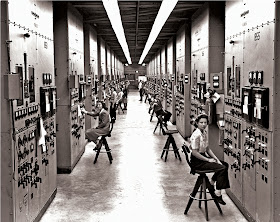I've written before about Oak Ridge and the Manhattan Project, the race with the Germans to build an atomic bomb during World War II. Much has been written about the Manhattan Project and the three sites (Oak Ridge, Tennessee; Los Alamos, New Mexico; and Hanford, Washington) that were created to carry out this important work. The latest focuses on the young women, many fresh out of high school, who were enlisted to fill critical jobs in Oak Ridge, jobs that could not be filled by men because they were off fighting a war.
The Girls of Atomic City by Denise Kiernan tells the oral histories of women who came to Oak Ridge in their teens to perform jobs that were held in tight secrecy. Interviewed when they were in their 80s and 90s, these women had had no inkling of what their jobs entailed until the news of the Hiroshima bomb dropping appeared in local newspapers. They knew only that the jobs were contributing to the war effort. Many came from distant places, not knowing what their destination was until their trains pulled into the station in Knoxville, Tennessee. And then they could not tell anxious parents back home anything about their new lives, only that they were well and contributing to winning the war. They came from farms and coal mining camps, small towns and big cities. They endured mud, shortages, and primitive living conditions. And they were surrounded by people their own age, with whom they socialized, eventually married, and created a town that exists today.
Because of the need for secrecy, cameras were contraband during the war, and workers were rigidly compartmentalized. Everyone twelve years old and older was required to wear a picture badge when on the reservation, including in the residential and business districts. Codes on badges told which buses people could board, which plant area they could enter, and to which floor or wing within a building they had access. Recognizing the need to document the whole project for history, the Manhattan Project employed a young photographer by the name of Ed Westcott, and gave him access to all areas. His photographs (some reproduced here) are the images we all now know of that time.
Most people working in Oak Ridge learned the nature of their jobs from news reports following the bombing of Hiroshima. Ms. Kiernan tells of excited housewives calling their husbands at work to tell them the news, only to be hung up on by husbands who feared their wives had just broken the ultimate rules of secrecy and had jeopardized their livelyhoods.
Terrible as these weapons were, most agree that their use hastened the end of the war and saved many lives. With the end of the war, the work in Oak Ridge was scaled back and the workforce shrank accordingly. As the GIs returned from the war, they were given jobs and replaced many of the women. Some moved away, but some stayed to eventually buy their homes from the government and create a stable community. Oak Ridge shrank from a wartime population of around 75,000 to fewer than 30, 000 people, a number that has remained fairly constant over the years.
Having lived in Oak Ridge for more than 30 years, I was well familiar with the overall outline of the story. It was easy to tell if Ms. Kiernan had done her homework. The answer is a resounding yes. Not only are the stories well researched, the writing is excellent, and these familiar stories have held my attention as if encountering the information for the first time. I recommend it.






Sounds interesting. I'll pick it up.
ReplyDeletewhat a fascinating book this sounds like! I'll look for it.
ReplyDeleteGreat book project, thank you for the review. I'll put the book on my wish list!
ReplyDeleteI came over from Vicki Lane's blog, your profile picture reminded me of "The River runs through it" and my father's fly fishing.
This sounds like a really good book Jim. I'm going to add it to my list. I miss your posts.
ReplyDeleteAs an Oak Ridge born baby of the early 70's; I'm always looking for more books to read. My grandfather worked in the plant and even a year or two before his passing he was not willing to tell me much! My family still owns our "C house" and the town still has magic! They are also allowing tours of the ORNL and Y-12 plants now. Look forward to the book!
ReplyDelete